Apples 101: How to Pick and Store
Michigan's Favorite Fruit
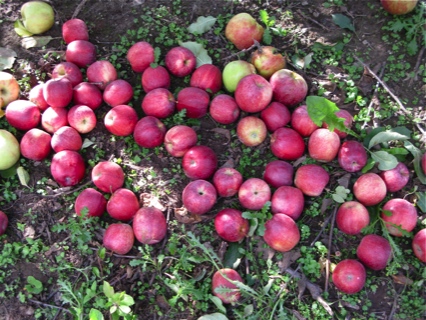
Michigan's Favorite Fruit

In addition, our cold winters allow the buds on apple trees to go dormant, ensuring proper growth in spring and summer. No area in Michigan is more productive in apple growing than the region in the western Lower Peninsula along Lake Michigan. That glorious lake effect helps to prevent extreme temperatures, resulting in a longer growing season. This is good news for apple lovers since the longer the growing season, the crisper the apple.
Thanks to this extended growing season, a great variety of apples is produced in Michigan. But selecting the right apple can be confusing. To make that next visit to the U-Pick a little easier, here’s a short primer on apple picking and storage. Btw, most apples in Michigan are grown on small family owned orchards so when you buy a Michigan apple, you are helping to keep small local farmers in business.
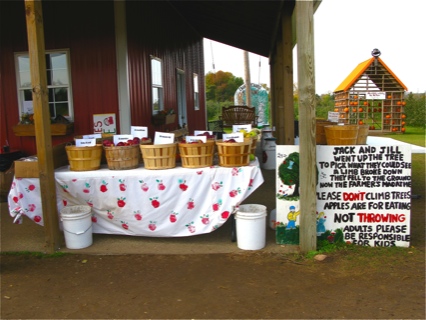
PICKING APPLES
Numerous varieties are grown in Michigan including: Blondee, Braeburn, Cameo, Cortland, Double Red Stamen, Early Gold, Empire, Fuji, Gala, Ginger Gold, Golden Delicious, Golden Supreme, Granny Smith, Gravenstein, Honeycrisp, Ida Red, Jersey Mac, Jonagold, Jona-Mac, Jonathon, McIntosh, Mollie Delicious, Mutsu, Newtown Pippin, Northern Spy, Paula Red, Pink Lady, Red Delicious, Red Haralson, Rome, Runkel, Snow Apples, Spartan, State Fair, Sweet 16, Tydeman Red, Wealthy, Winesap, Whitney Crab, Wolf River and York.
Whether you buy your apples from an orchard, farmers market or grocery store, keep an eye out for a variety you have never tried before. And remember that some apples are best eaten fresh, while others should be reserved for baking or cooking. September is usually viewed as prime apple picking time, but the variety known as Jersey Mac kicks off the season in August. And after September has come and gone, Michigan apple lovers still have a wide array of fruit to choose from throughout October.
When choosing an apple, smaller is usually better. Larger apples ripen quicker and they could be past their peak perfection. The skin should be bright, smooth and without cuts or bruising. Lightly squeeze the apple to make certain it is firm. Don't forget to sniff the apple since it should smell fresh. Apples are best bought in season. Because they store well, choose your favorites in the autumn. If properly stored, most apples can be enjoyed months after they have been picked.
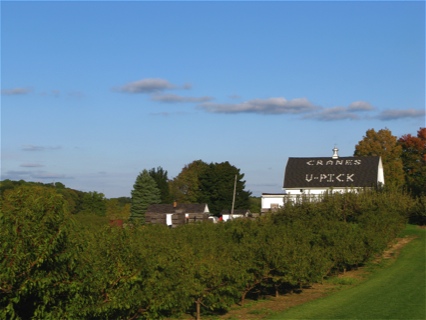
Apple lovers who plan to visit the local orchard, take heart. Most orchard trees are dwarf varieties; ladders and cherry pickers won’t be needed. Even the youngest apple picker can enjoy taking their favorite apples from the trees. Remember that the apples hanging on the outside of the tree ripen faster than those growing closer to the center. Don’t shake the tree or yank the apple from its branch. Instead, roll the apple upwards and gently twist it off. And try to leave the stem on. Some people believe the stem helps apples to last longer in storage. Finally, don’t just dump the apples in the bag or bushel basket. Bruised fruit will ripen – and rot – quicker.
To help decide which apples to pick and the best times to visit the orchard, here is a list and brief description of the more popular Michigan apples, along with the month they are likely to be ready for picking.
AUGUST:
Jersey Mac has a short growing season, but it does have the distinction of being one of the earliest apples to be harvested. The Jersey Mac is a juicy, firm medium-size apple that is great for eating rather than cooking, Its green color is overlaid with a pinkish red. Does not do well in storage. Ripens in mid August.
The late summer Paula Red is tart and aromatic. First grown in 1960 in Sparta, Michigan, a Paula Red is a great addition to the lunch box and makes fine applesauce. Because it softens when cooked, it is not recommended for baking pies. A bright red fruit with tan and yellow spots, the Paula Red is neither too tart nor too sweet. The apple becomes soft quickly so it will not store well. Ripens in mid August.
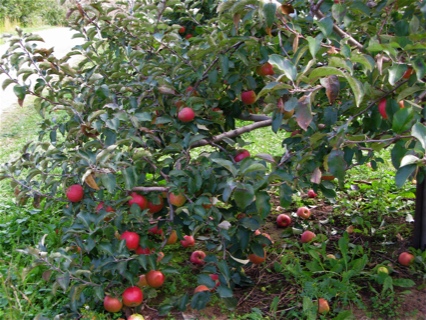
The early season Ginger Gold is both sweet and spicy. First grown in Virginia in 1969, the yellow Ginger Gold has a subtly tart flavor and succulent flesh. This fruit is the result of a cross between a Golden Delicious and an Albermarle Pippin. The all-purpose Ginger Gold cooks well, and is a tasty snack. Also used for cider. Can be kept in refrigerated storage for up to six months. Ripens mid to late August.
A late summer apple, Mollie Delicious boasts a sweet but mild flavor. A cross between a Gravenstein apple and a Golden Delicious, the Mollie Delicious was first sold in 1966. This juicy, conically shaped fruit not only bakes well, but makes a tasty snack or salad ingredient. Can be stored for up to ten weeks. Ripens in late August.
The Gravenstein can be traced back to a seedling in 17th century Denmark, but it may have been grown earlier in Italy. This yellow-green apple has a sweet yet tart flavor. Crisp and juicy, the Gravenstein tastes wonderful whether it is eaten fresh or used in baking, sauces, or cider. Not recommended for storage. Ripens late August to early September.
The Tydeman Red is a McIntosh-variety apple first grown in 1929 by Englishman Henry Tydeman. The Tydeman Red is a somewhat soft apple whose taste brings to mind a mix of maple syrup and cider. The peel imparts a faint cinnamon flavor. A good apple to use for desserts or sauce. Does not store well. Ripens late August to early September.
SEPTEMBER:
Although the red Cortland is an 1898 ancestor of the McIntosh, its white flesh is a bit sweeter. Since the Cortland also contains a tart undertone, it is often used in baking and desserts. An excellent apple for freezing, the Cortland is a good choice for juicing, saucing and salads. Can be stored for up to 3 months. Ripens in early September.
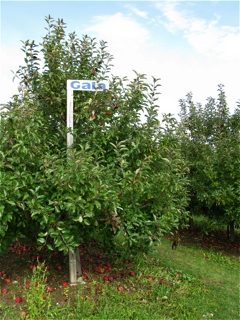
The crisp, sweet Gala ranks as Michigan’s third most popular apple. First grown in New Zealand in the 1920s, this small apple is a cross between a Golden Delicious and another hybrid variety called Kidd’s Orange Red. The Gala’s yellow flesh is great for eating fresh or cooking. Excellent for apple juice. May be stored for three months, but flavor will slowly fade even as the apple remains sweet. Ripens early to mid-September.
As its name denotes, the Honeycrisp is very crisp. It is also wonderfully sweet with a lovely color. A hybrid cross between a Macoun and a Honeygold, the Honeycrisp was developed in 1974. Great for snacking, or using in salads, sauces or pies. Can be stored in refrigerated storage for up to six months. Ripens early to mid-September.
The McIntosh is the best selling apple in Michigan. Ontario farmer John McIntosh developed this aromatic apple in 1811. Perfect for snacking, applesauce, cider, salads or pies, the McIntosh is probably the red and green apple that everyone is most familiar with. It is large, round, and slightly tart with crisp white flesh. Can only be stored for a short period of time. Ripens early to mid-September.
One of the most popular apples in Britain, the Empire is a favorite of Michiganders as well. A cross between a Red Delicious and a McIntosh, the Empire was first grown in 1945 in New York, (also known as the Empire State). Its taste is both sweet and tart, making it an ideal choice for snackers. Often used in baking and as the centerpiece of caramel apples, Empires do well in storage and can last up to three months. Ripens in mid-September.

Since a variety of Jonagold was discovered in Belgium, it is not surprising that Europeans love this aromatic apple. However the American cultivar was developed in New York in 1953. This popular juicy fruit is both tart and sweet. A cross between a Jonathon and a Golden Delicious, Jonagolds are delicious in cider, eaten fresh, or used in cooking. If you haven’t yet tried this large, very crisp apple, make certain to visit the orchards when they are being harvested. Jonagolds sell out quickly. Can be kept in refrigerated storage 1-2 months. Ripens in mid-September.
First grown in Iowa in 1880 to replace the Ben Davis apple, Red Delicious is the nation’s most popular apple. Crisp and mildly sweet, the robust flavor of the Red Delicious is best eaten fresh rather than cooked. And look for the characteristic five little bumps on the bottom of this bright red fruit. Can be kept in refrigerated storage for 3 months. Ripens in mid to late September.
Discovered in the 1870s in Wolf River, Wisconsin, the sweet red Wolf River is one of the larger apples grown. This pale red and yellow fruit is primarily used for cooking, baking and sauce. Ripens mid-September to early October.
The Snow Apple originated in 17th century Quebec and has long been a favorite dessert and cider apple. An ancestor of the McIntosh, this red and cream-colored small fruit is spicier than most. While Snow Apples are frequently used for cider or baking, they are also delicious eaten fresh. Can be stored for 1 to 2 months. Ripens in late September.
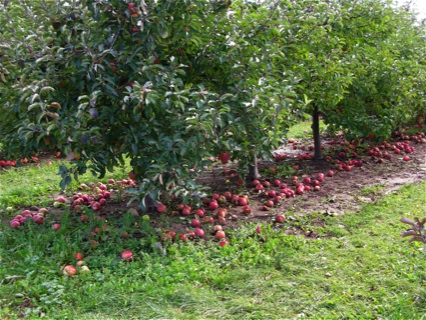
Rome is probably the red apple that Snow White would have been tempted by: large, round and both mildly sweet and tart. Discovered in Ohio in the early 19th century, it has since become a favorite of Southerners. It is the most popular baking apple due to its long-lasting flavor. Stores and freezes well. Ripens late September to early October.
One of the oldest American apples, the Newtown Pippin was a favorite of Thomas Jefferson. Also called Albemarle Pippin, this apple was discovered in 1759 on Long Island. The aromatic, tart green apple is perfect for cider, applesauce, and pies. Unless gardeners grow their own trees, most Michiganders rarely taste a raw Newtown as it is usually grown for commercial processing. Can be kept in storage for at least three months. Ripens in late September to mid October.
OCTOBER:
Bite through the thin skin of a Golden Delicious and discover its ginger-like sweet flavor. Perfect for eating fresh or as an ingredient in cooking or baking, the Golden Delicious is the most popular yellow apple. Discovered in West Virginia in the early 20th century, the Golden Delicious was the result of an accidental cross breeding of a Golden Reinette and a Grimes Golden. Be careful when handling a Golden Delicious as the fruit bruises easily. Can last up to 5 months when stored properly. Ripens in early October.
A cross between a Wagener and a Jonathon, the Ida Red was first grown in Idaho in 1942. A tart apple with remarkably crisp white flesh, the Ida Red is well suited for baking or sauces. Can last up to four months in refrigerated storage. Ripens in early October.
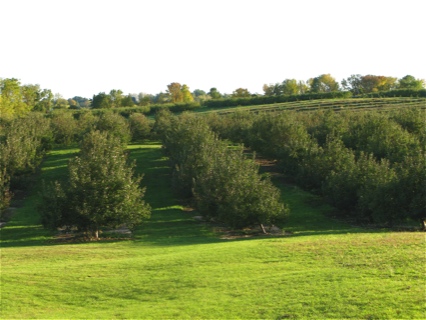
Native to New Zealand, the juicy Braeburn was discovered accidentally in the early 1950s. Possible contributors to this plant are the apple varieties Granny Smith and Lady Hamilton. The crisp, spicy Braeburn is excellent for snacking or cooking. Stores well for at least three months. Ripens in mid-October to early November.
The juicy, crisp Cameo appeared on the scene in Washington in 1987 when apple grower Darrel Caudle realized that the Red Delicious tree in his orchard was actually a ‘chance seedling’. Its germinated seeds came from unknown plants, although it is likely its parents were Red and Golden Delicious trees. The result was the Cameo apple, which quickly became popular with apple connoisseurs. More tart than sweet, the Cameo is best eaten fresh. Excellent when cooked, but only if used soon after it has been harvested. In 2002, this firm red and cream striped apple was voted one of Cooking Light Magazine’s best apple varieties. Does well in long-term storage. Ripens in mid-October.
Japan’s favorite apple, the Fuji has quickly become popular with Michigan apple lovers as well. A cross between a Red Delicious and a Ralls Janet, the Fuji’s low-acid content makes it the preferred apple for heartburn sufferers. The crisp fruit’s delectable flavor is more sweet than tart. Fujis can be stored for up to 8 months. Ripens in mid-October.
While the Jonathon was discovered in 1826 on a farm in Woodstock, New York, the growing conditions of Michigan produce some of the best Jonathons in the country. This juicy, tangy beauty is great for eating fresh or cooking. Like the Fuji, it has a low acid count. The Jonathon is an excellent choice for apple lovers looking for a sweet crisp fruit. Stores well for 2 months. Ripens in mid-October.
Often called ‘Gala with a zing’, the sweet but tart Pink Lady is great for snacking, baking or salads. Native to the Southern Hemisphere, a Pink Lady boasts a correspondingly bright pink color and white flesh. This crunchy winner is a result of cross breeding of a Golden Delicious and a Lady Williams. Ripens in mid-October.
The Runkel is the result of an accidental seedling discovered in Michigan’s Lincoln Park in 1940. This medium-sized apple has a deep rich flavor. Known for its juicy sweetness, the Runkel is perfect eaten fresh or used in cooking, baking or cider. Has a long storage life. Ripens in mid-October.
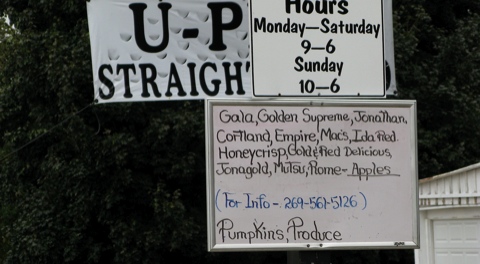
The crisp tart Mutsu initially appears as a green fruit before ripening to yellow. A cross between a Golden Delicious and several varieties of Indo apple, the Mutsu was first grown in 1948 in Japan. A perfect snack food, the Mutsu is also recommended for cooking, cider and sauce. Does well in refrigerated storage. Ripens mid to late October.
Apple bakers everywhere love the tart Northern Spy, which was first grown in New York in 1800. This hard, crunchy apple is descended from the antique Wagener apple. Look for the Northern Spy’s distinctive green skin marked by red stripes. Acidic and tangy, the Northern Spy is the perfect ingredient for pie, applesauce, juice and cider. Because it ripens late in the season, Northern Spy does quite well in storage. Ripens in mid to late October.
The dark red Winesap is a favorite of those seeking tartness in their apples. This juicy firm heirloom apple has a flavor reminiscent of wine. The Winesap is so attractive, it is frequently used in wreaths or store displays. The Winesap was first documented as a cider apple in 1804 Philadelphia, but evidence points to this small apple being known as early as Colonial Virginia. Does well in storage and in the freezer. Can be kept in refrigerated storage for over 3 months. Ripens in mid to late October.
The juicy red York apple was discovered in 1830 in Pennsylvania. Its sweet yet mildly tart flavor makes it a good choice for cooking, sauces, baking and apple pies. The York is one of the best storage apples when refrigerated properly. Ripens mid to late October.
In 1868, Maria Ann Smith grew a chance seedling in her small orchard in New South Wales, Australia. Due to her numerous children, she was known as Granny Smith, and this became the name of the new variety of apple she cultivated. A perennially popular fruit, a crisp, tart Granny Smith is excellent for snacking, baking and cooking. And it is one of the best apples to include in a salad. Granny Smiths have a very long shelf life and may be stored for a year given the right conditions. Ripens late October.
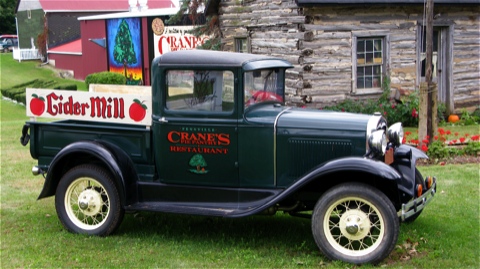
STORING APPLES
Unlike many other fruits, apples can maintain their freshness for a long period of time. To ensure this, refrigerate apples immediately unless you plan to eat them within a few days. Given proper conditions, some apple varieties can last for a year in storage. But remember to store apples as soon as possible after they’ve been picked. Also sort apples before storage. Combining different varieties of apples in the same bag or box is not recommended since ripening times vary for each type.
The apples that usually store best are those varieties harvested late in the season. And the tarter the apple or the thicker its skin, the longer it can be stored. All apples lose their tartness over time. If an apple has been bought for its tartness, do not be surprised at how sweet it becomes while in storage.
Store apples only if they are perfectly ripe. The best candidates for storage should have no bruises, blemishes or cuts in the skin. Any apple that is not perfect will hasten spoiling. Use any bruised apples for cider, sauce or pies soon after you have purchased or picked them. Homemade applesauce, canned pie filling and cider can last for over a year. Small and medium apples store much better than larger specimens, so eat large apples first. Some of the apples that do well in storage and can remain fresh for months are Cameo, Fuji, Gala, Golden Delicious, Granny Smith, Honey Crisp, Ida Red, McIntosh, Red Delicious and Rome.
To ensure the best results, store apples in boxes lined with perforated plastic, or in plastic bags with holes punched in them to allow air to circulate. Another way to store apples is to wrap each piece of fruit individually in newspaper; this protects the apple from exposure to one that is spoiling. However do not use colored newsprint. Place the wrapped apples in a cardboard box. Keep the boxed apples in a cool dark place where there is no danger of them freezing. The right humidity and temperature are crucial. Try to maintain 90% humidity and a constant temperature of 30 to 34 degrees Fahrenheit wherever the apples are being kept. (This is usually colder than most refrigerator settings.) If the temperature rises above 40, the apples ripen too fast; if the temperature is too cold, frost damage results.
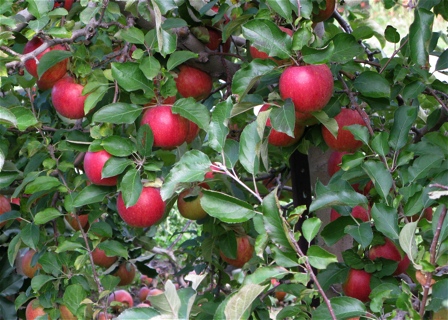
Among the places where apples may be stored are basements, root cellars, refrigerators, fruit cellars, enclosed porches or unheated attics and garages. Do not store apples near items such as potatoes, onions or garlic. Apples easily absorb the flavor of other fruits, vegetables or herbs. Finally, make certain to regularly check the apples being stored over the winter, and remove any fruit beginning to spoil.
For visitors or residents along Lake Michigan's southeastern shore who want to pick their own apples, please visit Lake Effect Living’s Apple Orchard page. And don’t forget that if it’s apple-picking time, pumpkins won’t be far behind. So take one last look at the long, lazy days of summer. The season of red and gold leaves, fresh-picked apples, homemade cider, pumpkins and hayrides is now upon us. And not a moment too soon either.
--Copyright © August 2013 Sharon Pisacreta
Resources for Apple Picking
Michigan Apples from the Michigan Apple Committee
Information About Michigan Apples from About.com
Apple Varieties from The Fruitful Orchard and Cider Mill
Tydeman's Michaelmass Red from Adam's Apples
Apple Flavors and What They Mean from The Yates Cider Mill
Apple Varieties from Produce Oasis
Pick the Perfect Apple from Apple Works Orchard
Simple tips on how to store apples for a long, long time from Backwoods Home Magazine
Apple Picking and Canning Tips from Pick Your Own
Over 870 apple based baking recipes from the Nestlé Very Best Baking website